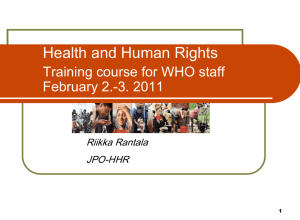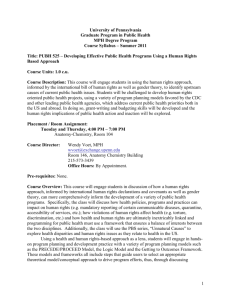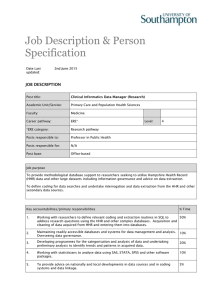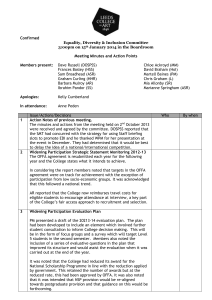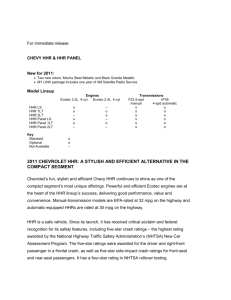C HHR P :
advertisement
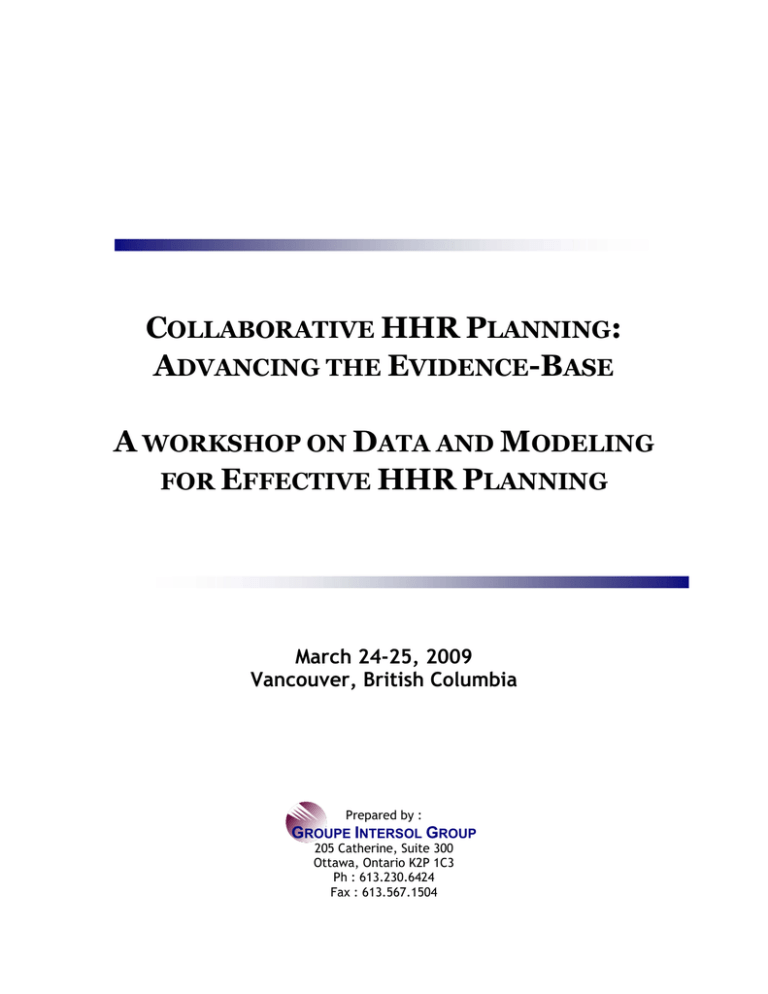
COLLABORATIVE HHR PLANNING: ADVANCING THE EVIDENCE-BASE A WORKSHOP ON DATA AND MODELING FOR EFFECTIVE HHR PLANNING March 24-25, 2009 Vancouver, British Columbia Prepared by : GROUPE INTERSOL GROUP 205 Catherine, Suite 300 Ottawa, Ontario K2P 1C3 Ph : 613.230.6424 Fax : 613.567.1504 Executive Summary On March 24th and 25th, 2009, a Health and Human Resource (HHR) Modeling Workshop was held in Vancouver, British Columbia to review HHR planning projects and successes, identify priority evidence and related gaps and challenges, and propose and prioritize realistic, actionable solutions to these gaps and challenges. This event was co-hosted by the Canadian Institute for Health Information (CIHI) and the HHR Planning Subcommittee of the F/P/T Advisory Committee on Health Delivery and Human Resources (ACHDHR), with the aim of furthering collaborative efforts to find solutions to the HHR challenge facing Canada today. The first day of the Workshop consisted mainly of presentations, followed by question and answer periods and table discussions. The aim of these presentations and discussions was to: • review and assess the initiatives undertaken in HHR planning, including in data and modeling since the 2003 and 2004 Health Accords, • reflect on the data of data and tools currently available for HHR planners and decision makers to achieve results, and • consider what results HHR planners and decision makers could achieve with enhanced data and tools. On the second day, participants worked in groups to design realistic projects that they felt would best address the gaps and challenges identified on the first day of the Workshop. Participants then prioritized the projects according to what they felt would be most useful and/or urgent in order to have a better idea of where efforts should be directed in the near future. Participants developed 14 projects, of which the top three priority projects are presented below: 1. Needs-based planning approach for populations of identified needs like francophone minority populations, Aboriginals and immigrants. The objectives of the project are to identify the specific population health needs of these identified groups, develop models of care that are tailored to the needs of these populations, and identify the competencies required to address these needs. 2. Rapid Response Modeling Toolkit to address knowledge transfer and exchange. The objectives of the project are to bring together decision makers and modeling experts, establish common definitions and standards for modeling inputs and showcase existing models in the provinces and learn from their challenges and successes. 3. Expand the national database to address missing data in existing databases. The objectives of this project are to expand the national database collection beyond the current 7 professions and include missing data elements in existing databases, and establish a common data set for all regulated health professions in Canada that includes complete information on demographic, geographic, educational and employment characteristics. Summary Report This report contains a brief summary of the presentations delivered on the first day, as well as the gaps and challenges identified by participants. Collaborative HHR Planning: Advancing the Evidence-Base Vancouver, British Columbia – March 24-25, 2009 1 Setting the Stage: Where We’ve Been and Where We Are in Evidence-Based HHR Planning Further details from all of the presentations are available in the handouts that were distributed to Workshop participants. Keynote Address: How Many are Enough? Why Public Service Matters Presented by Terry Goertzen – Assistant Deputy Minister, Health Workforce Division, Manitoba Health and Healthy Living Mr. Goertzen explained why simply counting the number of health professionals is not enough to address the issue of self-sufficiency in health human resources. Many factors, including Canadians’ changing health needs, expanded scopes of practice, advances in treatment and technology, and policy and economic realities, indicate that the issues are complex and that appropriate solutions require comprehensive analysis of all of these factors. Mr. Goertzen concluded by making the point that the public service can solve these complex problems and meet the health care challenges facing our Canadian communities by putting aside their personal agendas and working together for the common good. Panel: Perspectives on Successes and Challenges in Collaborative HHR Planning – the last 5 years This panel was moderated by Lyne St-Pierre-Ellis from the New Brunswick Department of Health. The panel included Regina Coady, Peter Gibson, and Adrian MacKenzie. The panel discussed successes and challenges in the following areas: • Data scope and standards • Analysis and modeling • Communication and collaboration • capacity Ms. St-Pierre Ellis opened the panel by pointing out that tremendous progress has been made in these areas in the past five years and that there is a much larger knowledge base available now than five years ago. In addition to five new supply-based databases for HHR on five groups of health professionals (occupational therapists, pharmacists, physiotherapists, medical laboratory technologists, and medical radiation technologists), CIHI is involved in a feasibility study on a unique identifier to track health care providers. The results of this study will be presented in the spring. Further work is being done with: • Collection of data on Aboriginal communities, • Identifying core competencies in HHR, and • Data analysis and modeling as well as HHR simulation and forecasting models. Ms. St-Pierre-Ellis noted that HHR planners are now more informed and coordinated. She encouraged participants to examine and improve the current system and continue to devise ways to collaborate. Workforce Models – An Employer’s Experience Presented by Regina Coady, Eastern Health Ms. Coady spoke about HHR planning from an employer’s perspective. She noted that long-term HHR planning is not a high priority for employers due to scarce resources and more immediate concerns, however there has been much progress in the last 10 years and employers are now considering factors such as competencies and scopes of practice. Collaborative HHR Planning: Advancing the Evidence-Base Vancouver, British Columbia – March 24-25, 2009 2 Employers do not always have the resources or expertise to do data modeling and their data analysis is often done for operational purposes. They are often most concerned with talent management, recruitment and retention, and succession planning with the ultimate goal being quality service delivery. The tools that employers use for planning include payroll systems, provincial pensions data, clinical practice standards, as well as data about utilization and population health. Ms. Coady emphasized that qualitative data is very important for successful HHR planning. Presentation by Peter Gibson, Western & Northern HHR Planning Forum Mr. Gibson spoke about why HHR planning is not just about data and modeling, it is about establishing the right model of health care delivery and optimizing the performance and effective productivity of the workforce. In order to establish this model, the following factors must be considered: • Effective Productivity • Outcomes for patients, not just quantitative outputs • National data standardization, evaluation and analysis of currently available data • Evaluation of policies and programs Some barriers to collaboration in modeling include: • Limited resources • Political implications • Variations in data • The need for models to constantly evolve • Intellectual property is difficult to share across jurisdictions • Poor dissemination and implementation of health research results Mr. Gibson proposed that an HHR Research network can directly link researchers and decision makers, to ensure alignment, collaboration and focus on key priorities to ask the right research questions and to collaboratively develop solutions. Effective Collaboration in HHR Planning Presented by Adrian MacKenzie, Dalhousie University Mr. MacKenzie summarized a number of successes and challenges in the four subject areas defined for this panel. The successes in data scope and standards include collection of data by Statistics Canada and CIHI on a variety of variables crucial to HHR planning. The challenges include silos of information, lack of data on key planning variables and the need for a unique identifier. The successes in analysis and modeling include an increase in acceptance of comprehensive models, consideration of a wider variety of factors like needs and productivity, a more open-minded approach to HHR modeling and a willingness to improve the current system. The challenges include lack of qualitative evidence and specific desired outcomes. In the area of communication and collaboration, Mr. MacKenzie acknowledged an improvement in sharing of methods and information between provincial governments. He also pointed out the challenges remaining in translating research and evidence into effective policies. There has been a growing recognition of the importance of building modeling capacity, but it remains challenging not only to build capacity in an ever-changing field, but to retain people with these skills. Collaborative HHR Planning: Advancing the Evidence-Base Vancouver, British Columbia – March 24-25, 2009 3 Principal Gaps and Challenges After the panel discussion, workshop participants held table discussions to identify the principal gaps and challenges in HHR data and modeling in Canada. Each table discussed one of four topic areas: • Data Scope and Standards • Analysis and Modelling • Communication and Collaboration • Capacity Participants identified the following overarching gaps and challenges that could be categorized in more than one or all of these topic areas: • Data standardization • Data sharing • Data completeness • Knowledge translation (communicating the data/evidence in a meaningful way for policy makers and other stakeholders) • Sustained collaboration and engagement After the table discussions, each group made a brief presentation on their top three gaps and challenges. Following is a summary of the results, by topic area. Data Scope and Standards A lack of standardization of data impedes effective HHR planning and analysis. In order to standardize data, the following are required: • A unique identifier for health professionals, • A consistent definition of variables, and • Consistent workload measurement systems. Sharing data across jurisdictions remains a challenge due to privacy issues, lack of collaboration and standardization, and insufficient capacity. Linkages between data on education, health care providers and service delivery are absent or ineffective. Specific data gaps include: • Data on qualitative outcomes for patient health and service. Much of the current data is on quantitative outputs. • Data on some health professionals, particularly those working in the privately funded system. • Data on specific populations, for example: Aboriginal, francophone minority, and rural communities. • Patient feedback information. Analysis and Modeling Gaps and challenges in analysis and modeling include: • Current analysis capacity is insufficient for evidence-based policy and decision making. • Analysis does not always include political, social and economic drivers. • Linkages between macro (provincial and federal) requirements and micro (more specific, front line) requirements are not well established. • There is insufficient assessment and evaluation of data to ensure data is valid and reliable. Collaborative HHR Planning: Advancing the Evidence-Base Vancouver, British Columbia – March 24-25, 2009 4 • There are insufficient technical tools and software available. • There is insufficient quality data available for proper analysis. Communication and Collaboration Gaps and challenges in communication and collaboration include: • A disconnect between elected officials, policy makers, and service delivery. Informed decisions require communication of valid, meaningful evidence. • Differences in definition of “needs-based” planning. • Privacy issues that impede communication between agencies that collect data. In order to improve communication and collaboration, the following are required: • The consistent ability to communicate electronic provider data across provinces and jurisdictions. Effective planning requires national collaboration. • Opportunities and mechanisms for a Pan-Canadian engagement of health professionals. • A consistent mechanism to communicate regularly on progress and best practices. Capacity The development of HHR planning capacity is challenged by: • An environment of expanding scopes of practice, • Insufficient allocation of resources to data collection and analysis in order to do robust modeling and planning, and • Appropriate engagement of all players, including smaller organizations which often have less capacity to collect and report data. Collaborative HHR Planning: Advancing the Evidence-Base Vancouver, British Columbia – March 24-25, 2009 5 Focus on Data and Modeling: Achievements and Challenges A Pan-Canadian Inventory, Assessment and Gap Analysis of HHR Forecast Models Presented by Rick Cameron, Cameron Health Strategies Group Mr. Cameron presented an overview of the 2007 Data and Modeling Workshop and an update on PanCanadian HHR Forecast models currently in use and being developed. The F/P/T Advisory Committee on Health Delivery and Human Resources (ACHDHR) Goals and Work Plan aims to “improve all jurisdictions’ capacity to plan for the optimal number, mix and distribution of health care providers based on system design, service delivery models and population needs.” This committee and other support mechanisms have been promoting collaboration in HHR planning and many initiatives are moving forward. National planning is starting to happen, but policy levers still reside in the jurisdictions. Economic constraints will put further pressures on the health system and will impact planning. Planning must also take into account Canada’s place within the international community. The objectives of the Pan-Canadian HHR Forecast Model Inventory are to • Update the inventory of HHR Forecast Models and • Assess gaps between capacity and needs Most organizations want to do needs-based planning, but this is difficult to accomplish in a complex environment with many unknowns. Planning is an inexact science that takes places in a social, fiscal and political context. The requirement right now is to define what the resources are and how they would be best managed. Health Human Resources Planning in British Columbia Presented by Eric Peraro, Health Employers Association of British Columbia Mr. Peraro shared information about the HHR planning process in British Columbia. His presentation covered process, data systems, and the HR forecasting model. The scope of the data used includes approximately 130 000 employees in the system and includes an encrypted unique identifier. The records track employees who work at multiple jobs at multiple sites. The data does not, however, include information about employees in the private sector. For 2009, the forecast covers 25 occupations. The variables used for the forecast include: • The number of staff at the start of the year • Demand for health care professionals • Recruitment gains, including new hires and additional educational seats • Employee losses through termination and retirement. The supply is determined by subtracting the employee losses from the recruitment gains. The gap is determined by subtracting the supply from the demand. Nova Scotia Medical Radiological Technologists (MRTs) Modeling Presented by Adrian MacKenzie, Dalhousie University Mr. MacKenzie delivered a presentation on how data modeling and forecasting led to the development of a new educational program for Medical Imaging Assistants in Nova Scotia. The data used included the supply of providers, number of graduates, work and productivity numbers, as well as the needs of the population by age and gender. This data was modeled in a way to allow the planners to test various policy scenarios. Collaborative HHR Planning: Advancing the Evidence-Base Vancouver, British Columbia – March 24-25, 2009 6 When CEOs expressed concern over a critical MRT capacity shortage, a study was undertaken and a simulation was run using the forecasting model. Based on the results of this research, the proposed solution was to introduce a new profession called Medical Imaging Assistants (MIA) to address the shortage. The Department of Health partnered with the Department of Education to design an educational pilot program for MIAs. Filling an Evidence gap: The Ontario Population Needs-Based Physician Forecasting Model Presented by Hussein Lalani and Dan Singh, Ontario Ministry of Health and Long-Term Care At the 2005 HHR Planning Workshop, physician supply forecasting models were discussed. At that time, there was information about supply, but the models were not able to specify whether that supply was appropriate. As a result of that gap, the Population Needs-Based Physician Forecasting Model project was undertaken. Mr. Lalani and Mr. Sing gave an overview of the project and the model structure. The Population Needs-Based Physician Forecasting Model includes a Supply Module and a Needs Module. The Supply Module uses information from multiple sources, including the Ontario Physician Human Resources Data (OPRHRDC), Canadian Post-MD Education Registry (CAPER), Canadian Institute for Health Information (CIHI) and the National Physician Survey (NPS). The information in the NPS helps determine the productivity of physicians more accurately. The Needs Module includes population demography and socio-economic and lifestyle risk factors based on information from Statistics Canada and the Canadian Community Health Survey. This data is weighted based on information from Disease Weights Experts Panels in order to determine population health needs. The Forecasting Model is now able to determine HHR requirements more accurately because it includes both the Supply Module and the Needs Module. The presentation concluded with lessons learned from this project: • Don’t be afraid. It can be intimidating to take research results and try to get quantifiable information into a theoretical model that works, but continued efforts will produce increasingly better results. • Don’t underestimate the amount of time it takes to get access to data. • Include a full update cycle of data in any contracts to create models. • Manage expectations. Ensure that people know that this is one piece of the puzzle, the model cannot produce all of the desired results. • Make the development of the model as transparent as possible and engage stakeholders early in the process so that people can understand how the model is built. The more people understand the model, the better the critiques and the product will be. Collaborative HHR Planning: Advancing the Evidence-Base Vancouver, British Columbia – March 24-25, 2009 7 List of Proposed Projects On the second day of the workshop, participants worked in teams to design the projects that they felt would be both realistic and useful in addressing the gaps and challenges in HHR today. Each team gave a brief presentation on their project, and then participants voted to prioritize the projects. Participants designed the following projects, listed by priority: Priority Total # Votes Project Name 1 19 Challenges of Populations of Identified need 2 15 Rapid Response Modeling Toolkit (RRMT) 3 15 Expand the National Database 4 15 Canadian Health Human Resources Observatory (CHHRO) 5 13 Creating an HHR Minimum Data Set 6 13 Implementation of a National Unique Identifier 7 13 Pan-Canadian Health Occupation Definitions 8 12 HHR Planning – Knowledge Management 9 9 HHR Planning – Knowledge Management Network of Employers Share Best Practices Focussing on Model Service Delivery 10 9 Enhancing the Robustness of Geographic Distribution Analysis of HHR 11 8 Standardization of Terminology and Metrics, Forecasting Methodologies 12 7 Expanded Disease Surveillance 13 5 Lack of Information on Traditional Health Providers Within Aboriginal Populations 14 3 Identify long term health risk factors to support health needsbased planning Short Descriptions for Top Five Priority Projects This section includes a short description of the top five priority projects. For full details on all of the projects, including enablers and challenges, project scope and organizations involved, see Appendix B – Projects Details. 1. Challenges of Populations of Identified Need Description: Needs-based planning approach for identified populations like francophone minority populations, Aboriginals and immigrants to address their specific needs. Proposed objectives: to identify the specific population health needs of these identified groups, develop models of care that are tailored to the needs of these populations, and identify the competencies required to address these needs. Collaborative HHR Planning: Advancing the Evidence-Base Vancouver, British Columbia – March 24-25, 2009 8 Proposed outputs: an inventory of health status by identified group, relative to thee general Canadian population, an appropriate mix of health care providers available to provide services to these populations, and provision for the formation of health professionals in the required competencies. Proposed outcomes: improvement in health status and improved access to care or utilization of services for identified populations. 2. Rapid Response Modeling Toolkit Description: toolkit to address knowledge transfer and exchange. Proposed objectives: bring together decision makers and modeling experts, establish common definitions and standards for modeling inputs and showcase existing models in the provinces and learn from their challenges and successes. Proposed outputs: knowledge transfer, collaboration, buy-in for creating an action team, and capacity building. Proposed outcomes: the creation of an action team that is supported by provincial jurisdictions and provider group modelers which will test models with benchmark data and lead to consensus on subsequent pilot of enhanced model. 3. Expand the National Database Description: Expand the national database to include missing information. Proposed objectives: expand the national database collection beyond the current 7 professions and include missing data elements in existing databases, and establish a common data set for all regulated health professions in Canada that includes complete information on demographic, geographic, educational and employment characteristics. Proposed outputs: gap analysis by province and regulated profession. Proposed outcomes: better information for pan-Canadian health human resource planning which will enable the development of analytical tools such as needs-based forecasting models. 4. Canadian Health Human Resources Observatory (CHHRO) Description: Establish a pan-Canadian coordinator or champion for health human resources priorities that is independent, non-partisan, evidence-based, and science-based. Proposed objectives: establish the CHHRO, define problems and identify their root causes, propose solutions to these problems and define terms of reference. Proposed outputs: comprehensive data across disciplines, connect data to health outcomes, panCanadian educational coordination, and knowledge transfer. Proposed outcomes: improved pan-Canadian coordination of health human resources planning, establish mechanisms for cooperation, better knowledge transfer to decision makers, and comprehensive, quality, outcomes related data. 5. Create an HHR Minimum Data Set Description: create a minimum data set to address lack of standardization and inconsistent definition of variables and terms. Proposed objectives: develop a standardized health human resources minimum data set and bring remaining regulated and unregulated health occupations to a basic level of information. Proposed outputs: a tool for various stakeholders to support primary data collection. Proposed outcomes: a comparable data set that includes demographics and basic education requirements. Collaborative HHR Planning: Advancing the Evidence-Base Vancouver, British Columbia – March 24-25, 2009 9
